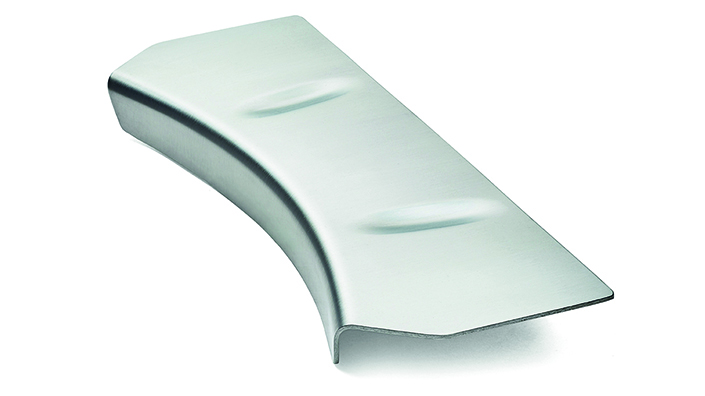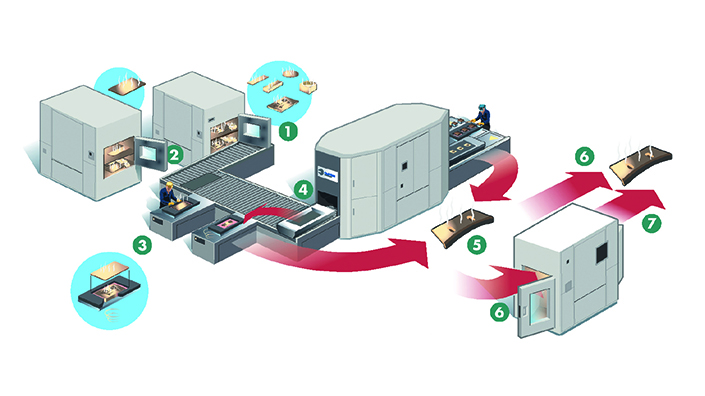Instead of forming the sheet metal between two expensive heavy machined steel dies, the approach uses only one hard die surface. The other is replaced by a rubber diaphragm, which forces the workpiece against its hard counterpart by hydraulic pressure to create the required final part geometry.
Further details of how the process operates and of the benefits it can facilitate are provided by Sture Olsson, head of business development for metal forming. He says, for instance, that an immediate plus factor is that the use of a soft-contact surface for one face of the blank can significantly reduce the risk of in-process surface marking of the workpiece. In addition, the technique also simplifies initial set-up procedures because it removes the requirement for the precise alignment of the two die halves when both are exact hard machined units.
Costs cut
Nevertheless, the process itself can facilitate the forming of more complex shapes. “It can form undercuts without any need for sleeves to come in from the sides,” he says. The maximum pressure the technique can exert on a part is currently around 1,400bar or 140MPa.
But perhaps the most immediately tangible benefit is the sharp reduction in initial capital outlay resulting from the need to machine only one steel die rather than two. “We can cut that by 50% and sometimes by as much as 90%,” Olsson states. The reason that savings can in some circumstances be well over 50%, he explains, is that it allows the hard die half for some applications to be made from an inexpensive and easy-to-machine material such as wood or plastic. Alternatively, the machined half can be made from a zinc alloy that can be repeatedly re-melted and reused whereas a steel die would instead have to be scrapped – a factor that can reduce costs over an extended period.

Economic production of even single parts could be feasible (Credit: Quintus Technologies)
There are, Olsson concedes, limitations on the applicability of the technology but ones that are more concerned with production volumes and timescales. He says quite frankly that the technique is not appropriate as a means of high-volume production. “It is for prototyping and low-volume applications,” he states, with low volume in that context realistically meaning from “a single part to between 5,000 and 10,000 parts per year per component”.
Moreover, while conventional stamping can form a part in just a few seconds, the Flexform process may in contrast take “a few minutes”. There are, though, ways to mitigate the effects of that limitation. One is that the technique does allow the simultaneous creation of multiple parts. Olsson says that when the process uses a rectangular forming bed with a maximum size of nearly 2m in width and 4m in length then several sets of forming tools can be placed on it, side by side.
Doors and roofs
On that count Olsson adds that, although the production of up to 15 parts at the same time has been achieved, four is a more likely upper limit for relatively sizeable units such as those for automotive applications, which might typically involve a set of doors – left and right and front and rear. He confirms that the technique is in real practical use by high-end automotive manufacturers. Daimler, for instance, uses it to produce the roof of its Maybach vehicle, while Bugatti uses it to make doors. In Sweden Volvo employs Flexform as its primary prototyping technique where the material involved is mild steel.
Indeed, Olsson confirms that mild steel is by far the most common material the process is used to form, certainly in the automotive industry, although in aerospace applications it may be used with more unusual materials such as Inconel. But in either case a primary reason is that the use of the rubber diaphragm has restricted the technique to cold-forming applications in which no heating of the metal is possible.
Intriguingly that fundamental limitation now no longer applies. As Olsson confirms, a new version of the technology called High-Pressure Warm Forming that can cope with workpiece temperatures as high as 300°C has been developed. A primary target application area is the forming of titanium parts in aerospace manufacturing although the company’s belief is that it would be equally applicable to the manufacture of parts using the alloy in other areas including turbines and medical devices. Moreover, Olsson adds that it is possible that at some future point it could be adapted for the production of magnesium parts, which in turn would make it relevant to the company’s current major market of automotive manufacturing.
Titanium on the up
Details of how the technique has been adapted for use at the temperatures involved are not revealed. Olsson does say, though, that the new capability involves the deployment of a flexible insulating layer between the workpiece and rubber diaphragm to protect the diaphragm and the hydraulic oil behind it from temperature-related degradation. He indicates that it has been developed initially to meet a requirement for the manufacture of titanium parts in the aerospace industry where the use of titanium has been ramping up steadily for some time. Today’s Airbus A350, for instance, uses 4.5 times more titanium than its 1992 predecessor the A330.
As Olsson explains: “Pure titanium is relatively easy to bend at ambient temperature but the aerospace industry currently uses alloy formulations that require to be formed at temperatures between 600 and 900°C in ‘hot’ or even ‘superplastic’ techniques, but both approaches are slow and expensive when it comes to the die manufacturing.”

Titanium alloys have applications in aerospace manufacturing (Credit: Quintus Technologies)
In particular, he adds, the aerospace industry has targeted a specific titanium alloy, Ti-6Al-4V, as one that it wants to make use of because of a series of attributes it possesses including high strength-to-weight ratio, ability to withstand extreme temperatures, and chemical inertness which allows it to resist the oxidation that might cause corrosion in use. As the chemical formulation indicates, the alloy is 90% titanium, 6% aluminium and 4% vanadium.
In detail the alloy is classified as grade 5, which means it has several distinctions from the commercial pure titanium grades 1-4, not least heightened formability requirements. While grades 1-4 are formable at room temperature, fabrication of Ti-6Al-4V parts currently requires the application of very high temperatures, which not only adds to the complexity of the operating environment but makes the whole process very lengthy. Current hot-forming processing times are typically measured in hours, including lengthy periods for furnace start-up and material cool-down.
Faster process
But, Olsson continues, Quintus has already demonstrated in its own research and development that “we could reduce the required temperature down to as low as below 300°C by adding pressure to the equation so that we could speed up the process significantly and make the dies much more cheaply”.
Nevertheless, even something in the region of 300°C is still way above the temperature at which the Flexform process normally operates and is obviously way above the level at which the integrity of the rubber diaphragm can be maintained. But, again, Olsson is adamant that the new process will work as expected. “We have carried out tests and shown that it does work in reality and that we do not damage the material when we form it at this sort of temperature,” he states.
Under wraps
Ensuring the safe formability of the titanium is still only one requirement, with the other being maintaining the integrity of the rubber that presses it into shape. Although the details of how that is achieved remain confidential, Olsson does reveal that the equipment itself remains largely unchanged from the format used in the ambient-temperature Flexform process. The key factor is that the interposition between the diaphragm and the workpiece of a form of flexible insulation that prevents the transmission of heat in one direction does not in any way inhibit the transmission of the force in the other direction that will impose the required final geometry on the workpiece.
But Olsson does also provide indications of a couple of other factors that are involved to help facilitate the process compared with the previous implementation of the Flexform approach. One is that the process now involves induction heating which he says helps provide a rapid temperature distribution between the workpiece and the die. “With induction heating you instantly get the required temperature distribution in the die,” he states.
The other factor is a significant increase in the pressure exerted on the workpiece by the diaphragm from around 600-800bar or 60-80MPa to as high as 1,400bar or 140MPa. As such Olsson is emphatic in his belief that this new process is far more than just an upgrade to the existing technology and instead has profound implications for this area of metals manufacturing: “I would say that we can revolutionise the way titanium can be formed,” he says.
Want the best engineering stories delivered straight to your inbox? The Professional Engineering newsletter gives you vital updates on the most cutting-edge engineering and exciting new job opportunities. To sign up, click here.
Content published by Professional Engineering does not necessarily represent the views of the Institution of Mechanical Engineers.